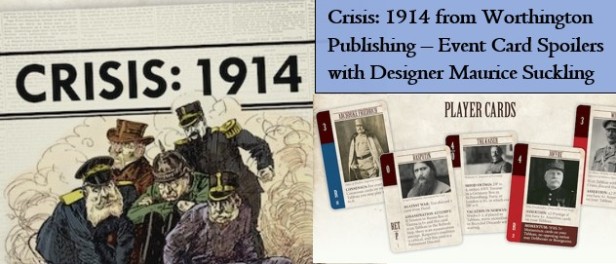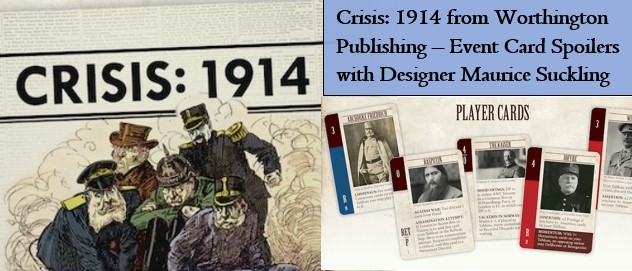We became acquainted with Maurice Suckling with his game Freeman’s Farm 1777 from Worthington Publishing in 2019 and really enjoyed the mechanics and how they all came together to create an interactive and interesting look at the Battle of Saratoga during the American Revolution. Since that time, Maurice has designed several other games that have went on to successful Kickstarter campaigns including Hidden Strike: American Revolution, Chancellorsville 1863 and 1565 Siege of Malta. He is now working on a game that is tied to the buildup of tensions that led to the outbreak of The Great War called Crisis: 1914 from Worthington Publishing, which was successfully funded on Kickstarter this past summer. He has prepared a series of Event Card Spoilers for the game and we are hosting them here on the blog. These posts will share the cards basis in history as well as how they are used in the game.

If you are interested in ordering Crisis: 1914, you can pre-order a copy for $65.00 from the Worthington Publishing website at the following link: https://www.worthingtonpublishing.com/collection/crisis-1914-pre-order-this-game-will-not-ship-until-february-2024
Introduction to the Game
Crisis: 1914, designed by Maurice Suckling, and published by Worthington Publishing, is currently at the printers with plans to begin shipping to backers in February. It is a 1-5 player game about managing the diplomatic crisis that gave rise to what became known as the First World War. In this game, players are attempting to navigate through international brinkmanship and to avoid war. There is more information about the game on Worthington’s website: https://www.worthingtonpublishing.com/collection
Ahead of the game’s shipping, we’re running a series of Event Card spoilers to help explain how they work.
The Cards
Each player takes on the role of one specific diplomat, corresponding with one of the five major powers who were engulfed by the crisis – Count Leopold Berchtold (Austria-Hungary), Sergei Sazonov (Russia), Theobold von Bethmann Hollweg (Germany), Raymond Poincaré (France), Sir Edward Grey (Britain). Each player has one deck consisting of 24 cards. Each of these cards has the same basic design format. The cards are played to a tableau in front of players, as they attempt to score more Diplomatic Pressure (DP) Points than the other players, without generating so much Tension that they lose the game by compelling other players to mobilize.

In addition to the six card types outlined above, there is a seventh card type – a General Mobilization Card – which ends the game. Players must attempt not to play these cards from within their own hand or deck and may try to force other players into playing these cards from their own deck. Austria-Hungary, Russia, and Germany have these cards. France and Britain do not. Let’s first take a look at these General Mobilization Cards.

Austria-Hungary Card #23
Austro-Hungarian General Mobilization
Austria-Hungary mobilized on July 28, 1914 against Serbia (Clark 2012, 469). Identified as “Plan B” (for the Balkans), the order expanded to a general mobilization on July 30th to account for the need to defend the nation’s eastern border against the Russian general mobilization in progress – i.e., “Plan R” (for Russia) (Ham 2013, 366).
As you can see on the card, the art here used is propaganda used against Serbia after the assassination of Archduke Franz Ferdinand and his wife Sophie in Sarajevo on June 28, 1914.

Russia Card #23
Russian General Mobilization
On July 29th, Foreign Minister Sazonov and Generals Sukhomlinov and Yanushkevich order a general mobilization; just before midnight, the Czar downgrades the order to only a partial one. At 1:45am on July 30th, the Kaiser receives the Czar’s telegram and informs him that partial mobilization measures were decided five days prior. By 2:00pm, Sazonov persuades the Czar to rescind his partial mobilization order and reinstate a general mobilization (Ham 2013, 355-360).

Germany Card #24
German General Mobilization
While awaiting clarification of Russia’s general mobilization on July 30th, Moltke and Falkenhayn press Bethmann Hollweg to mobilize. Bethmann Hollweg wants more time, and together they decide upon a deadline of noon the next day. At 11:55am on July 31st, Pourtalès confirms that Russia’s general mobilization is underway; that evening, the Kaiser declares Kriegsgefahrzustand (a state of war emergency, or threatening danger). General mobilization begins August 1st (Ham 2013, 359-360; Clark 2012, 548).
Maurice has provided an extensive bibliography for the series and you can find that below:
References for the Blog Series
Albertini, Luigi. 1965a. The Origins of the War of 1914, Volume I. Translated and Edited by Isabella M. Massey. Oxford: Oxford University Press.
Albertini, Luigi. 1965b. The Origins of the War of 1914, Volume II. Translated and Edited by Isabella M. Massey. Oxford: Oxford University Press.
Alder, Douglas D. 1978. “Friedrich Adler: Evolution of a Revolutionary.” German Studies Review 1, no. 3 (October): 260-284.
Alpha History. n.d. “The Austro-Hungarian Ultimatum (1914).” Accessed August 23, 2023. https://alphahistory.com/worldwar1/austro-hungarian-ultimatum-1914/
Balfour, Michael. 1964. The Kaiser and His Times. London: Cresset Press.
Bankers’ Magazine. 1914. “The Great Crisis,” Volume XCVIII (September).
Barnes, Harry Elmer. 1929. The Genesis of World War. New York: Alfred A. Knopf.
Beatty, Jack. 2012. The Lost History of 1914: The Year the Great War Began. New York: Walker & Company.
Berenson, Edward. 1992. The Trial of Madame Caillaux. Berkeley: University of California Press.
Bestenreiner, Erika. 2004. Franz Ferdinand und Sophie von Hohenberg. München: Piper.
Black, Eugene. 1987-1988. “Edwin Montagu.” Jewish Historical Studies 30: 199-218.
Carter, Miranda. 2009. The Three Emperors: Three Cousins, Three Empires and the Road to World War One. London: Fig Tree (Penguin Books).
Clark, Christopher. 2012. The Sleepwalkers: How Europe Went to War in 1914. New York: HarperCollins Publishers.
Embassy Magazine. n.d. “The lamplighters of London.” Accessed August 23, 2023. https://embassymagazine.com/the-lamplighters-of-london/.
Engelstein, Geoffrey, and Isaac Shalev. 2022. Building Blocks of Tabletop Game Design, 2nd Edition. Boca Raton, FL: CRC Press.
Farrar, Marjorie M. 1980. “Politics versus Patriotism: Alexandre Millerand as French Minister of War.” French Historical Studies 11, no. 4 (Autumn): 577-609.
Ferguson, Nial. 1999. The Pity of War. London: Penguin Books.
Fromkin, David. 1989. A Peace to End All Peace: The Fall of the Ottoman Empire and the Creation of the Modern Middle East. New York: H. Holt.
—. 2004. Europe’s Last Summer: Who Started the Great War in 1914? New York: Vintage Books.
Godsey, William D. 1999. Aristocratic Redoubt: The Austro-Hungarian Foreign Office on the Eve of the First World War. West Lafayette, IN: Purdue University Press.
Ham, Paul. 2013. 1914: The Year The World Ended. North Sydney, NSW: William Heinemann.
Jalland, Patricia. 1976. “A Liberal Chief Secretary and the Irish Question: Augustine Birrell, 1907-1914.” The Historical Journal 19, no. 2 (June): 421-451.
Jarausch, Konrad H. 2015. Out of Ashes: A New History of Europe in the Twentieth Century. Princeton: Princeton University Press.
Jelavich, Barbara. 1992. “Romania in the First World War: The Pre-War Crisis, 1912-1914.” The International History Review 14, no. 3 (August): 441-451.
Joll, James. 1984. The Origins of The First World War. London: Longman.
Joll, James, and Gordon Martel. 2023. The Origins of The First World War. New York: Routledge.
Langensiepen, Bernd, and Ahmet Güleryüz. 1995. The Ottoman Steam Navy, 1828–1923. London: Conway Maritime Press.
Leonard, Raymond W. 1999. Secret Soldiers of the Revolution: Soviet Military Intelligence, 1918-1933. Westport, CT: Greenwood Press.
Margutti, Albert Freiherr von. 1921. Vom alten Kaiser: Persönliche Erinnerungen an Franz Joseph I. Leipzig: Leonhardt.
Martel, Gordon. 2014. The Month That Changed The World: July 1914. Oxford: Oxford University Press.
Massie, Robert K. 2000. Nicholas and Alexandra. London: Ballantine Books.
McMeekin, Sean. 2013. July 1914: Countdown to War. London: Basic Books.
Mombauer, Annika. 1999. “A Reluctant Military Leader? Helmuth von Moltke and the July Crisis of 1914.” War in History 6, no. 4 (November): 417-446.
—. 2001. Helmuth Von Moltke and the Origins of the First World War. Cambridge: Cambridge University Press.
Neuberger, Joan. 1993. Hooliganism: Crime, Culture, and Power in St. Petersburg, 1900-1914. Berkeley: University of California Press.
New York Times. 1914a. “Favorite of Czar Stabbed by Woman.” Accessed September 1, 2023. https://timesmachine.nytimes.com/timesmachine/1914/07/14/101921091.pdf.
New York Times. 1914b. “Wounded in Russian Riots.” Accessed September 1, 2023. https://timesmachine.nytimes.com/timesmachine/1914/07/23/101722106.pdf.
New York Times. 1914c. “Army Ends Russian Riots.” Accessed September 1, 2023. https://timesmachine.nytimes.com/timesmachine/1914/07/25/100676942.pdf.
Nomikos, Eugenia V., and Robert C. North. 1976. International Crisis: The Outbreak of World War I. Montreal: McGill-Queen’s University Press.

Otte, T.G. 2014. July Crisis: The World’s Descent Into War, Summer 1914. Cambridge: Cambridge University Press.
Palmer, Alan. 1994. Twilight of the Habsburgs: The Life and Times of Emperor Francis Joseph. New York: Atlantic Monthly Press.
Pares, Bernard. 2001. The Fall of the Russian Monarchy. London: Phoenix.
Ponting, Clive. 2003. Thirteen Days: Diplomacy and Disaster, The Countdown to the Great War. London: Pimlico.
Raicer, Ted. S. 2009. Crowns in the Gutter: The Strategies of the First World War. Bakersfield, CA: Strategy & Tactics Press.
Roberts, Richard. 2013a. Saving The City: The Great Financial Crisis of 1914. Oxford: Oxford University Press.
—. 2013b. “The unknown financial crisis of 1914.” OUPblog. Accessed August 23, 2023. https://blog.oup.com/2013/11/unknown-financial-crisis-1914/.
Rapoport, A., and A.M. Chammah. 1966. “The Game of Chicken.” American Behavioral Scientist 10, no. 3: 10–28.
Sagan, Scott D. 1986. “1914 Revisited: Allies, Offense, and Instability.” International Security 11, no. 2 (Fall): 151–175.
Schindler, John R. 2015. Fall of the Double Eagle: The Battle for Galicia and the Demise of Austria-Hungary. Lincoln: Potomac Books / University of Nebraska Press.
Spence, Richard B., and Linda L. Nelson. 1992. Scholar, Patriot, Mentor: Historical Essays in Honor of Dimitrije Djordjević. Boulder: East European Monographs.
Stefanovics, Glenn W. 2003. “Janós Forgách Graf von Ghymes und Gács.” Solving Problems through Force. Accessed August 23, 2023. http://www.oocities.org/veldes1/forgach.html.
The National WWI Museum and Memorial. n.d. “Italy Enters World War I.” Accessed August 23, 2023. https://www.theworldwar.org/learn/about-wwi/italy-enters-world-war-i.
Thompson, Wayne C. 1978. “The September Program: Reflections on the Evidence.” Central European History 11, no. 4 (December): 348-354.
Time. 1932. “France: Death of Briand.” Accessed August 23, 2023. https://content.time.com/time/subscriber/article/0,33009,743324,00.html.
Trachtenberg, Marc. 1990-1991. “The Meaning of Mobilization in 1914.” International Security 15, no. 3 (Winter): 120-150.
Tuchman, Barbara. 2004. The Guns of August. New York: Presidio Press.
Tucker, Spencer C., ed. 1996. The European Powers in the First World War: An Encyclopedia. New York, Garland Publishing.
Tunstall, Gordon A., Jr. 2003. “Austria-Hungary.” In The Origins of World War I, edited by Richard F. Hamilton and Holger H. Herwig. Cambridge: Cambridge University Press.
Wien, Stanley. 2017. Ambassador for Peace: How Theodore Roosevelt Won The Nobel Peace Prize. n.p.: Lulu Publishing Services.
Williamson, John G. 1971. Karl Helfferich, 1872-1924: Economist, Financier, Politician. Princeton: Princeton University Press.
Williamson, Samuel R., Jr. 1991. Austria-Hungary and the Origins of the First World War. New York: St. Martin’s Press.
Zagare, Frank C. 2011. The Games of July: Explaining the Great War. Ann Arbor: University of Michigan Press.
If you are interested, we posted an interview with the designer and you can read that at the following link: https://theplayersaid.com/2023/07/12/interview-with-maurice-suckling-designer-of-crisis-1914-from-worthington-publishing-currently-on-kickstarter/
-Grant
